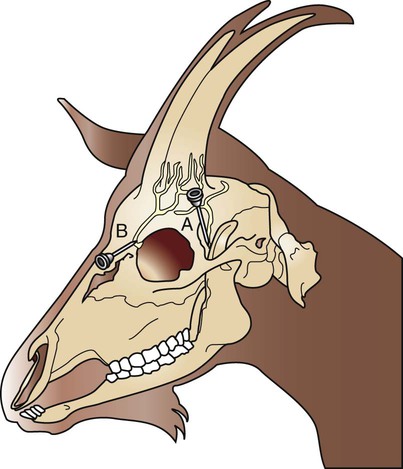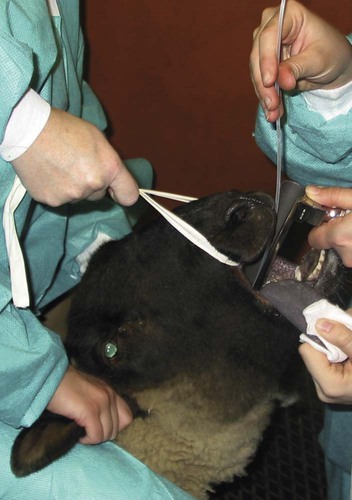When you have completed this chapter, you will be able to • Display understanding of the basic differences between standing surgical procedures and general anesthesia procedures • Prepare a sheep or goat for surgery • Assist and/or perform induction and maintenance of anesthesia • Provide anesthetic monitoring • Manage the patient during recovery and immediate postoperative periods • Display understanding of the basic risks and possible complications associated with anesthesia and surgery, and implement preventive measures when indicated Surgical procedures for small ruminants are similar to those for cattle. This chapter outlines the considerations and variations that should be made for small ruminant surgery. The reader should consult Chapter 12 for basic information on ruminant surgery. Goats have a dual nerve supply to each horn; therefore, two sites must be blocked. The cornual branch of the infratrochlear nerve is blocked at the dorsomedial margin of the orbit, at a depth of approximately 0.5 cm. A 22- to 25-ga needle is used, and local anesthetic is deposited (0.5 ml for kids, 1–3 ml for adults) (Fig. 16-1). In animals weighing less than 150 lb, facemask induction is possible. Adult sheep and goats may resist facemask induction unless they are sick or sedated. Oxygen (3–5 L/min) is given for 1 to 2 minutes before the anesthetic gas is introduced. Recommended gas concentrations are halothane 3% to 4%, isoflurane 3%, and sevoflurane 4% to 6%. Intubation is performed as soon as depth of anesthesia allows. A long-blade laryngoscope is useful for calves and small ruminants (Fig. 16-2). As with other species, appropriate size of endotracheal tube is estimated by palpation of tracheal diameter through the skin of the neck and usually is 10 to 12 mm in adults. Other commonly used drugs include diazepam and ketamine combinations and propofol in small ruminants.
Ovine and Caprine Surgery
Small Ruminant Surgery and Anesthesia
Control of Pain
Cornual Nerve Block

General Anesthesia
Inhalant Gases

![]()
Stay updated, free articles. Join our Telegram channel

Full access? Get Clinical Tree


Ovine and Caprine Surgery

 inches long.
inches long. -inch to 3-inch spinal needle. A trocar is not needed for the procedure. In goats and sheep, the recommended volume of lidocaine is 2 to 5 ml per site. When the distal paravertebral approach is performed, a 20- to 22-ga × 1-inch needle is used in small ruminants, with 2 to 4 ml of lidocaine administered.
-inch to 3-inch spinal needle. A trocar is not needed for the procedure. In goats and sheep, the recommended volume of lidocaine is 2 to 5 ml per site. When the distal paravertebral approach is performed, a 20- to 22-ga × 1-inch needle is used in small ruminants, with 2 to 4 ml of lidocaine administered. -inch needle for caudal epidural administration. Because of sensitivity to local anesthetics, the dose should not exceed 0.5 to 1 ml of 2% solution per 50 kg body weight in sheep and goats.
-inch needle for caudal epidural administration. Because of sensitivity to local anesthetics, the dose should not exceed 0.5 to 1 ml of 2% solution per 50 kg body weight in sheep and goats.